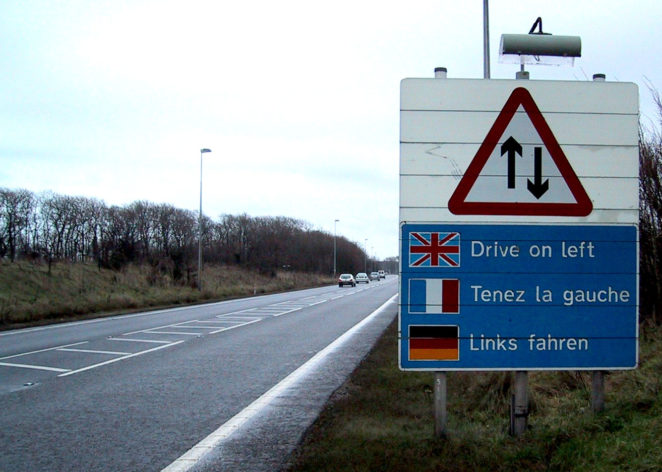
You have just arrived in the UK for
your visit, picked up your hire car and ... got into the passenger side by
mistake! This is one of a relatively small number of countries where the rule
of the road is that you drive on the left, which also means that most cars have
right-hand drive. That in itself presents a few challenges for those who are
not used to it, but let’s concentrate here on the peculiarities of actually
driving on the left.
When driving along a narrow road, whether
in town or country, you will inevitably meet somebody coming the other way.
Your natural tendency will be to swerve to the right to make room for the other
vehicle. In Britain,
this could cause a head-on crash, because the other driver will be swerving to
his/her left, which is what you should have done. You must concentrate at all
times and “think left”.
This is also essential when you need to
turn into a multi-lane road that has a central refuge. Suppose that you have
been on a minor road and have stopped when it meets a junction with a main
road. To turn right, you must cross the traffic in two goes, stopping again
before joining the flow of traffic going your way. Many nasty accidents have
been caused when overseas drivers have forgotten where they are and turned
right into the first carriageway they meet and not the second. You must also,
of course, remember that at the first crossing the traffic is coming from your
right and at the second it is coming from your left.
When you turn right from a main road into a
side road you will be turning across the opposite side of your road, with
traffic coming towards you from your left as you turn. Whereas turning left was the tricky turn
where you come from, here it is turning right. Also, be sure to turn into the
left side of the road you are turning into, and not the right side.
Roundabouts are a particular feature of the
British road system that you may not be used to. The rule is that you always
give way to traffic approaching from your right, which means traffic that is
already on the roundabout. A typical roundabout might contain four roads
leading into it. As you approach, there will probably be two lanes marked out,
one with arrows pointing left and straight on, and the other with an arrow
pointing to the right. Only go into the right-hand lane if you are turning
right, otherwise stay in the left-hand lane. Go round the roundabout on the
“outside” if turning left or going straight on, and the “inside” if turning
right, moving across as you approach your exit.
Many large roundabouts have the lanes
marked with the number of the road (and the direction) to which they lead.
These lanes will take you in exactly the direction you want to go, so be sure
that you know the number you need to follow!
Overtaking is always done on the right-hand
side, and it is important to move back to the left after you have finished your
manoeuvre. Many bad accidents have happened when non-British drivers have
forgotten this and have carried on driving on the wrong side of the road.
On multi-lane roads, such as motorways, it
is essential to remember that overtaking on the left is only permitted when
traffic is badly held up. Under normal circumstances this is definitely not
allowed. This also means that it is not permitted to stick in the middle lane
if the left-hand lane is clear. If you need to pass someone who has forgotten
this rule, you must go all the way round to the third lane and then back again!
Everything said here assumes that you are driving
a right-hand drive car. Should you be in a left-hand drive car you will face
some extra difficulties. In particular, when overtaking you will find it more
difficult to see the traffic coming the other way. You may need to rely on your
passenger to act as look-out in these events, or be careful not to get so close
to the vehicle in front that you cannot see what is coming towards you.
It is important to make good use of your
mirrors at all times, and to be aware of everything that is going on around
you. Because your natural reactions are “all wrong” when driving on the left,
and you will need more time to respond to the situations you will encounter, it
is essential to give yourself enough time to adjust. That means driving a
little slower than you might otherwise be used to. As in so many other things,
better safe than sorry!
It will not take long to get used to
driving on the left, and your reactions will gradually become more natural.
However, you do need to concentrate all the time which means that driving may
be more tiring for you. You therefore need to stop and rest more often than you
might do when driving at home. Mind you, you are driving in the UK, so
there is usually something worth stopping for!
© John Welford
No comments:
Post a Comment